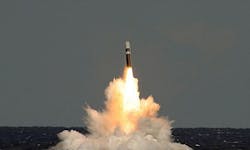Lockheed Martin to manufacture new Trident II D5 submarine-launched nuclear missiles
Officials of the U.S. Navy Strategic Systems Programs (SSP) office in Washington are asking the Lockheed Martin Space Systems segment in Sunnyvale, Calif., to provide new procurement of Trident II (D5) missiles, D5 life extension development and production, and D5 deployed systems support.
The contract modification has options that could increase its value to $1.48 billion, Navy officials say. The Trident II D-5 is the primary U.S. sea-based nuclear ballistic missile, and is deployed aboard U.S. Navy Ohio-class ballistic missile submarines.
The U.S. Navy operates 14 of these ballistic missile submarines, each of which can carry as many as 24 Trident II missiles. Although the Trident II is designed to carry as many as 12 multiple independently targetable reentry vehicle (MIRV) warheads, current treaties reduce this number to four or five.
Each Trident II missile has a range of 4,000 to 7,000 miles. The Trident II D-5 was first deployed in 1990 and is scheduled to remain in service until at least 2027.
Related: Air Force asks Boeing to upgrade test gear for nation's Minuteman III nuclear missiles
The Navy started the D-5 Life Extension Program in 2002 to replace obsolete components using as many commercial off-the-shelf (COTS) parts as possible to keep costs down and to enhance the missile's capability.
The Charles Stark Draper Laboratory Inc. in Cambridge, Mass., is in charge of upgrading the Trident II's guidance system, and has been working on this project since 2005.
In practice, the Trident II missile's inertial measurement system receives targeting data from computers aboard the submarine. The inertial measurement unit then transmits signals to the D-5 flight-control computer and converts them into steering commands to keep the ballistic missile on target.
The missile's post-boost control system maneuvers the missile in flight to observe stars for the missile's celestial navigation subsystem, which updates the inertial system in flight.
Lockheed Martin also is integrating the Trident II onto the next-generation ballistic submarine designs of the U.S. and United Kingdom by adapting the Trident II missile and reentry subsystems into the common missile compartment for the Ohio replacement and United Kingdom successor programs.
The Ohio replacement is being designed to replace the Navy's fleet of Ohio-class ballistic missile submarines. The United Kingdom successor program, meanwhile, will replace the Royal Navy's fleet of Vanguard-class ballistic missile submarines.
The U.S. Navy today operates 18 Ohio-class submarines -- 14 of which carry the Trident nuclear missile, and four of which have been modified to carry conventionally armed long-range cruise missiles.
The Ohio-class submarines have been in commission since 1981, and are scheduled to be decommissioned and replaced starting in 2029. The United Kingdom Vanguard-class ballistic missile submarine has been at sea since 1993. The Royal Navy operates four Vanguard-class subs.
On this contract modification to build new Trident nuclear missiles, Lockheed Martin will do the work in Sunnyvale, Calif.; Cape Canaveral, Fla.; Brigham City, Utah; Silverdale, Wash.; St. Mary's, Ga.; Pittsfield, Mass.; El Segundo, Calif.; Kings Bay, Ga.; Gainesville, Va.; Kingsport, Tenn.; Clearwater, Fla.; Lancaster, Pa.; Elkton, Md.; Inglewood, Calif.; Palo Alto, Calif.; and other locations, and should be finished by November 2020.
For more information contact Lockheed Martin Space Systems online at www.lockheedmartin.com/us/ssc, or the Navy Strategic Systems Program office at www.ssp.navy.mil.
